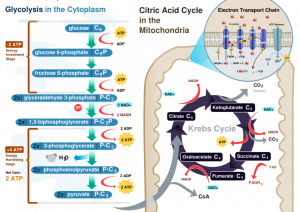What is Lactic Acid?
Posted on | July 9, 2010 | 5 Comments
Ever notice that when you run, you can breathe easily initially and then you get more and more out of breath and start to breathe faster trying to gasp for more oxygen. Your legs starts to burn and they feel heavier with each step. Finally, it hurts so bad and you feel totally out of breath that you had to stop?
Lactic acid (Chemical name: 2-hydroxypropanoic acid) is the cause.
It is produced by our body mainly in muscle and red blood cells and is also found naturally in dairy products such as yogurt. It is important to understand Lactic acid production and our metabolism so you can bust fat every time you work out.
Aerobic vs. Anaerobic Respiration
In order to understand how and why lactic acid is produced, you first have to understand how our body produces energy,
Our body generates energy aerobically (with oxygen) and anaerobically (without oxygen) but it prefers to generate most of its energy using aerobic respiration.
The first key and common step of the metabolic pathway for both the Aerobic and Anaerobic respiration is Glycolysis. During Glycolysis, glucose is broken down into pyruvate through a series of steps.
When the body has plenty of oxygen, pyruvate is broken down to acetyl-CoA and is shuttled to Citric Acid Cycle / Krebs Cycle to be further broken down for more energy.
Glucose + Oxygen → Energy + Carbon dioxide + Water

Cellular Respiration
Aerobic respiration produces a higher energy yield than compared to the Anaerobic pathway. However, when oxygen is limited, the working muscles would then generate energy anaerobically, temporarily converting pyruvate into lactic acid (Lactate)
This allows continued energy production. Glucose (Broken down to) → Energy + Lactic acid
The working muscle cells can only sustain anaerobic energy production at high rates for 1 to 3 minutes, during which lactic acid accumulate to higher levels.
Lactic acid production is our body natural defensive mechanism.
Lactic acid causes the burning sensation during intense exercise. It is our body natural defensive mechanism to prevent permanent damage during extreme exertion needed to maintain muscle contraction. Once lactic acid level exceeds our own body threshold, the working muscles shut down.
However, when the intensity of the exercise is reduced, oxygen becomes available and lactic acid is reverted back to pyruvate and anaerobic pathway is switch back to the aerobic pathway. This allows the body to produce energy for recovery from the strenuous event.
Muscle Fatigue: Contrary to popular belief, Lactic acid buildup is not responsible for the muscle soreness felt in the days following strenuous exercise.
Researchers who have examined the lactic acid levels right after exercise found little correlation with the level of muscle soreness felt a few days later. The delayed-onset muscle soreness, or DOMS is characterized by sometimes severe muscle soreness or tenderness as well as loss of strength and range of motion, usually reaching a peak 24 to 72 hours after the extreme exercise event.
Though the exact cause of DOMS is not known, most research points to damage of muscle cells (micro tears) and an increased release of other metabolites as the cause of soreness and swelling.
Lactic acid an alternative energy source?
Not only is Lactic acid not responsible for DOMS, it is now believed that lactic acid could actually be another fuel source for working muscles.
New research is indicating that instead of lactic acid being a by-product of anaerobic respiration, lactic acid is absorbed and converted to a fuel by mitochondria in muscle cells. Unfortunately, the exact process is still in the midst of research.
Injuries and Performance
Injuries can occurs when one continues to ignore the body’s signals and push against the body’s own limits. On the other hand, if one does not push to increase their lactate acid threshold, they usually do not see progress in their performance.
For endurance events such as cycling, distance running and meds online without prescription swimming, by training at a high intensity (lactate threshold training) it is thought that the body can be conditioned to create additional proteins that help absorb and convert lactic acid to energy.
Lactate Threshold training involves interval training where one exercises at near maximum intensity, recovers for only a short while and then it’s repeated.
A pace that you can hold breathing fast and deeply, but not gasping for breath, is called the Lactic Acid Threshold and is the training level for most competitive athletes.
Lactic acid and Fat Burning
Performance might be all about how you condition the body to increase its lactic acid threshold. But if you are looking to lose weight, you need to burn calories and active stored energy release. Hence: The theory of exercising in a “fat burning zone” is derived.
Since aerobic respiration produces the most energy and lactic acid production halts the activity. It has been suggested for those looking to lose weight to exercise at a moderate intensity. This way, you burn more calories and you are able to exercise longer. However, many fitness experts are opposed to this thought. They argue that because weight loss equates to calorie burn; exercising at higher intensity burns far more calories during a short period of time.
Which ever fitness school of thoughts you prefer, remember to listen to your body through lactic acid production.
Related posts:
Tags: how is lactic acid produce > how to prevent muscle soreness > how to reduce lactic acid > lactic acid and injuries > lactic acid production > what is aerobic respiration > what is anaerobic respiration > what is lactic acid





July 9th, 2010 @ 1:56 pm
I think the last paragraph could be the reason why people suggest that interval training is best for fat loss; since no one can can agree then just do both..
July 9th, 2010 @ 2:46 pm
I am a very big fan of interval training at high intensity – I certainly don’t feel guilty if I only can complete 15 minutes of running stairs with minimal rest! Thanks for your comment
July 9th, 2010 @ 11:07 pm
So if I hope to see the result of my mass gaining exercise… I’ll have to work beyond my lactate acid threshold, am I right…!?
If so, how am I to know that i’ve reached/pass that threshold..!?
July 10th, 2010 @ 6:16 am
What is Lactic Acid? : The Health Guru…
I found your entry interesting do I’ve added a Trackback to it on my weblog :)…
July 14th, 2010 @ 9:59 am
Hi… thanks for your comment. The point of the article was more to cover the misconception that “Lactic Acid causes muscles soreness” and also that Lactic acid is a by-product of the body’s working cells when different energy systems are used -as soon as intensity is lowered, the lactic acid is remove by the body. If you are training for hypertrophy, you need to be completing resistance exercise to 80-90% effort at a maximum of 6 reps each set.